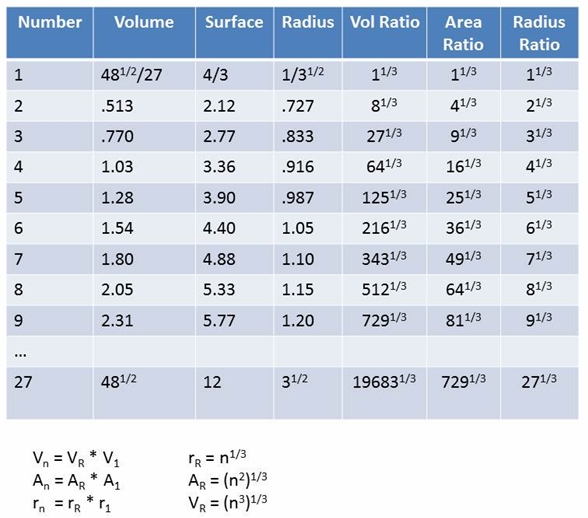As I have already admitted, to my chagrin, I was trying to build the LRC’s preon model using the 2D square root of 2-based number system, but I couldn’t get there. When I realized my mistake, I started over, using the correct 3D square root of 3-based number system, but now I had to deal with a very disconcerting challenge: Whereas the volume of the incorrect 2D TUDR was eight times the volume of the incorrect 2D SUDR, the volume of the correct 3D TUDR is 27 times the volume of the correct 3D SUDR!
True, the preon model was doable with these numbers (based on 3), but only if certain volumes were selected, the volumes of 9, 18 and 27 SUDR sums. While this meant that the radius of the TUDR (31/2) was three times the radius of the SUDR (1/31/2), so that the color charges of the quarks and the electrical charges of the electron and positron and the neutrality of the neutrinos worked out, as they should, the thirds were divided up into 3*9=27 increments of volume, each additional SUDR adding only a fraction of the required third!
For a day or two, this seemed to me to be a fatal flaw, but today I’m happy to report the discovery of what surely must be the answer: If we divide each increment of volume by its inverse and then cube that value, the only increments that come out as integers are 9, 18 and 27! All other volume increments are not integers. They are all irrational numbers. What this means, I believe, is that all volume increments except these three are excluded from forming combinations with their reciprocal counterparts by the discrete postulate of the RST. Happy day!
Readers can test this assertion themselves using the chart in figure 1 below:

Figure 1. Chart of 27 SUDR Volumes Summing to One TUDR Volume.
The values in the volume, area and radii columns are mostly rounded off irrational numbers, so the respective ratios must be used to get the actual numbers. This is done by multiplying the indicated ratio by its respective value in the column of the initial SUDR (row 1). The rounded off values in each row can then be used as an approximate value to check to ensure that the correct value has been calculated.
For example, for the ninth volume, we multiply the cube root of 9 by the inverse of the square root of 3, which gives us the radius for the ninth volume. Then, squaring the radius and cubing it, gives us the integer 3. Doing the same thing for number 18 yields the integer 12, while it yields the number 27 for n = 27.
As far as I can tell, no other n than these three meets the requirement.
Whew!!